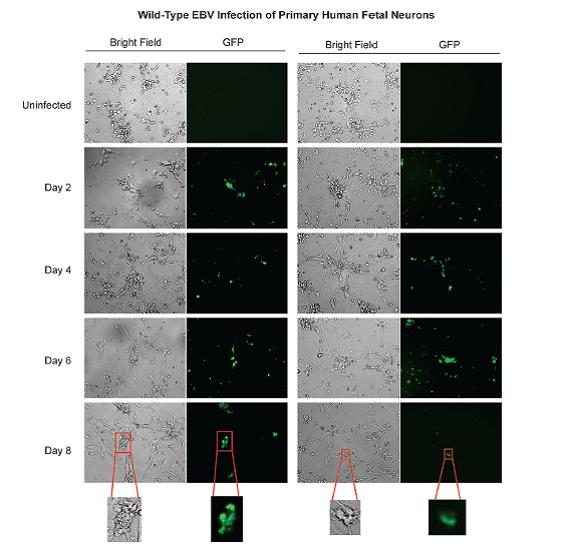
For some mysterious reason, whether Epstein-Barr virus (EBV) and Kaposi’s sarcoma-associated herpesvirus (KSHV) can infect neurons has not been established until now. Probably because some viruses from the same family do not infect neurons, so it was assumed that EPV and KSHV do not either.
Jha et al. (2015) cultured Sh-Sy5y neuroblastoma cells, teratocarcinoma Ntera2 neurons, and primary human fetal neurons in Petri dishes and then exposed them to these viruses. After infection, the authors did some fluorescence microscopy (they tagged the viruses with fluorescent dyes), real-time PCR (to confirm there was viral RNA in the cells), immunofluorescence assays (to see if the viral proteins are expressed) and Western blot analyses (to see if the specific viral antigens are made). All these showed that the viruses were happily multiplying in the cells.
Now here comes the significance of the study: EBV and KSHV are viruses associated with all sorts of nasty diseases like mononucleosis and cancers. EBV has also been associated with neurological disorders, like multiple sclerosis, Alzheimer’s, neuropathies, lymphomas etc. But the critical word here is “associated”. That is, they found these viruses in people suffering from those diseases. So the knowledge that these viruses infect neurons could point to a mechanism behind these associations. Unfortunately, EBV is present in 90-95% of the population of the world. Which means that you will find this virus in, let’s say, 9 out of 10 people suffering from Alzheimer’s, assuming normal distributions and random sampling. So the virus’s presence maybe completely unrelated to the disease. By the same rationale, you would find the virus in 9 out of 10 people found guilty of theft, for example. It would be then interesting to see find what is NOT associated with.
Caveat: I have not read the association studies, so my argument holds only if what they report is that people with disease X also have EBV. If they made, however, a comparisons and found out that people with disease X are significantly more likely to be infected with EBV than the ones without the disease, then the argument does not hold.
Reference: Jha HC, Mehta D, Lu J, El-Naccache D, Shukla SK, Kovacsics C, Kolson D, Robertson ES (1 Dec 2015). Gammaherpesvirus Infection of Human Neuronal Cells. MBio, 6(6). pii: e01844-15. doi: 10.1128/mBio.01844-15. Article | FREE FULLTEXT PDF | PsyPost cover
By Neuronicus, 7 December 2015

